 BIBLIOGRAPHY
BIBLIOGRAPHY
|
|
Formative Years
|
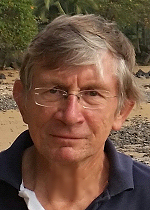

- Born in the Netherlands, enjoyed classic Gymnasium ß education with all the usual rebellion, began publishing immediately after graduation, serially dropped out of law, psychology, and Sanskrit at Amsterdam University while making a living as a journalist and translator, experimenting with psychedelics, and kicking off his career as public speaker at Leyden and Ghent universities for student audiences. At age 23 he joined IBM as technical writer,
to be fired soon after on grounds of non-conformity; then joined FHV, the hottest ad agency in town, as junior copywriter.
- In 1968 he began a nearly three year journey through the Middle East and the Indian subcontinent, about half of it with fellow writer Ewald Vanvugt, described in Across the Bedrock of Islam, collecting material for another work of non-fiction and feature
articles, photographing for Syndication International, trekking and climbing in the Himalayas and bathing in the Ganges, studying sitar at the feet of Ravi Shankar's father in law, the 'violent saint' Ustad Allauddin Khan,
and recording traditional music for the Elektra Nonesuch series, and
for Moses Ash's legendary Folkways Records (now a department of the Smithsonian Institution). Both are represented in musicological collections world-wide. In 2015 the Amsterdam Tropenmuseum
interviewed him (in Dutch) about his journey for a short video used in an exhibition about young people travelling to the East in the
sixties.
|
|
Midlife
|
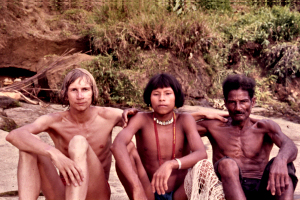
|
 |
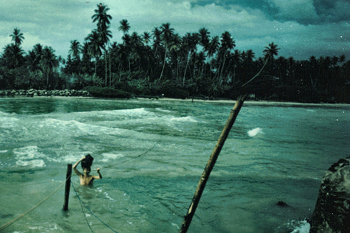
|
In the Choco jungle, Colombia, with Cholo indian and rower, 1974.
Photo Ewald Vanvugt.
|
|
Wading back to Taprobane with supplies, 1984.
Photo Ineke ten Hoopen.
|
|
- Upon return to Europe in the early seventies Peter practiced his craft as a writer doing literary translations, journalism, advertising copywriting. He joined two art-directors in setting up the successful Hotshop boutique agency,
writing campaigns for the same IBM that fired him a few years earlier. He dabbled in the visual arts, doing spray-painted geometrical works, and setting up Hotshop Gallery, which enjoyed a spectacular opening with one-man show
by Franz Deckwitz, enlivened by Fong Leng models and inebriated celebrities, but soon went bust as his partner suffered personal collapse. He traveled on all continents, frequently returning to the Asia he loves, and started
his collection of Indonesian ikat textiles, Pusaka Collection, by now one of the world's finest private collections.
- In the mid-seventies he teamed up with Vanvugt again to explore the Andean countries, going deep into the jungles of the Choco and the Putumayo, worked in Amsterdam and New York as a feature writer and interviewer, met the future
mother of his children and life-long companion, and made his debut as a novelist. (See Bibliography.) Among those who allowed him in-depth home interviews were Salman Rushdie,
Tom Wolfe, Paul Theroux, and the late Bruce Chatwin, with whom he shared a deep love for Afghanistan.
- In the early '80s he showed art photography in a GKf group show at the Stedelijk Museum, published his second novel, a comic drama about a consultant involved in international mergers such as, ironically, he would himself become
thirty years later, soon followed by the Dutch original of Precious Possessions,
a collection of short stories set in the tropics, written during on a long journey through India and a month on Taprobane Island, the private island
off the coast of Sri Lanka that was previously owned by Paul Bowles.
- In 1984/85, as writer in residence, Peter taught creative writing at the University of Michigan, a granddaughter of Franz Kafka among his
students, while writing a fourth work of fiction, based on A Fresh Load of Angels, a novella set in Peru, about a priest struggling with his urge to join the guerillas in the mountains. In the same year he co-founded award-winning
Amsterdam advertising agency Viegen, Vergouw & ten Hoopen. Built dreamhouse on the lake and collected dreamcars.
|
|
Sabattical Years
|
-

|
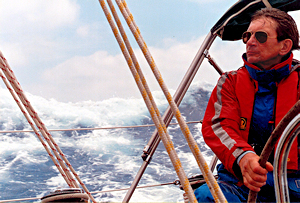
|
|
Sailing 45 ft cutter Sereia from Madeira to Lagos, Portugal in rough weather. The photo reflects the author's favourite self-image: 'in control under challenging circumstances'. Photo Steven van den Berg.
|
In 1993 he sold agency share and dream-properties, and took his wife and two sons, then aged 7 and 8, on a slow journey around the world, trekking through South and South-East Asia, Australia, New Zealand and the USA, with a three
year spell in New York's Westchester County, watching the deer in his backyard in between trips to the city, then back again to the old world - while writing a trilogy on the mood and mind of the sixties, two of them in English, King Acid and High Across the Bedrock (later translated into Dutch) and one in Dutch, Heilige voor Halve Dagen ('Part-time Saint'). He spent much of the last decades on rural properties in Southern Portugal.
- A passionate ocean sailer fortunate enough to have yacht-owning friends, he has made several blue water voyages: multiple times up and down the rugged Iberian Atlantic coast, to the Madeira archipelago, and across the Atlantic
to the Azores, both from Bermuda and from Lagos, the ancient port near stormy Cape St. Vincent where the Portuguese explorerers left for their voyages of discovery that gave us the world.
|
|
Maturity
|
- In 2000 Peter ten Hoopen established a consulting practice in the field of corporate culture and leadership, serving clients in various countries, helping them to bridge cross-cultural divides, and create 'winning corporate cultures'. For three years he advised the board of De Baak, one of Holland's leading management training institutes.
- In late 2006 he joined Trompenaars Hampden-Turner, one of the world's leading consultancies in the field of corporate culture, giving workshops on cross-cultural effectiveness
on four continents, including stints in Iran, Syria, Dubai, Uganda, Sudan and several other countries in the MEA area. His 2005 publication, Geluk in Zaken ('Corporate Happiness'),
shows how to achieve real success in business by optimal use of given talents, using insights and techniques that work equally well for individuals and organisations. The essence of the book's message is: 'Focus on work you can do wholeheartedly.'
- In 2008, with economist Marleen Janssen Groesbeek, he published Oh, wat zijn we creatief! ('Gee, are we ever creative!') an in-depth study on the factors that stimulate and hinder creativity in organisations, supported by Financieele Dagblad. The survey used Peter's own survey software, that was also used in two other major surveys with FD, one on leadership and one on managers' sources of job satisfaction and sense of fulfillment. Addicted to programming since the mid '80s, he has developed scores of programs, surveys and websites, in a variety of languages, including C and PHP.
- His 2009 book The Enlightened Leader, with co-author Fons Trompenaars, explores the type of leadership that one might justifiably call enlightened, and with the 'Chakras of Leadership', inspired by Yoga philosophy, introduces a practical way to develop the necessary heightened awareness of personal qualities and of universal connectedness. It is supported by the Chakra Test, a survey by now taken by twenty thousand people from all over the world. In 2010 he went digital with Roving Star Press, publishing ebooks for the Amazon Kindle
.
|
| Full Bloom
|

|
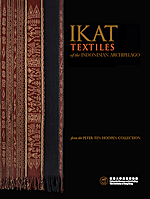
|
|
Distributed by Hong Kong University Press, Chicago University Press, Periplus and Wiley.
|
In 2011, closely following his own prescriptions, he began manifesting his passion for Indonesian ikat textiles by forming a carefully curated, archipelago-wide collection. The Pusaka Collection is unparallelled in its level of documentation and through its vast website attracted international attention. In a 2014/2015 he partnered with Museu do Oriente in Lisbon to create the historic exhibition 'Woven Languages'; historic in that it was the world's first comprehensive exhibition dedicated exclusively to traditional Indonesian ikat textiles. It was covered extensively by magazines such as Hali, Orientations, Carpet Collector. The exhibition lives on in the catalogue Woven Languages.
- In 2017 Hong Kong University Museum and Art Gallery followed up with a larger exhibition, 'Fibres of Life', again widely covered, e.g in Hali. The substantial catalogue, Ikat Textiles of the Indonesian Archipelago (602 pages), was launched in at an event organized by the Royal Asian Art Society of the Netherlands in Amsterdam's Rijksmuseum in 2018. At 604 pages, with 450 illustrations, it is the world's first comprehensive reference work on the subject.
-
In 2018 Museu do Oriente in Lisbon exhibited the Timor section of the Pusaka Collection (substantially enlarged after Hong Kong) along with some of its own ikat from the island, and three pieces from a Swiss collection under the title 'Timor: Totems and Tokens'. An eponymous 192 pages catalogue edited by Peter ten Hoopen carried contributions from Jill Forshee, Pierre Dugard, Georges Breguet and Linda S. McIntosh. The project stood out by the rather large number (20+) of ikat textiles from East Timor, a region so devastated by turmoil, especially during the years of its struggle for independence that it lost nearly all of its material heritage.
-
On the strength of his work Ikat Textiles of the Indonesian Archipelago was invited to pursue a PhD at Leiden University. He undertook a study of ikat textiles from the eastern archipelago from a technical and design-technical perspective which had not previously been attempted, which resulted in the dissertation Ikat from Timor and its Outer Islands: Insular and Interwoven, successfully defended at age 77 on 1 September 2022.
|




